Групповые политики Active Directory позволяют централизованно применять одинаковые настройки ко множеству компьютеров и/или пользователей домена и существенно упрощают управление конфигурацией в доменной среде. Консоль Group Policy Management Console (GPMC.msc) – это основной инструмент для управления групповыми политиками (Group Policy Object, GPO) в Active Directory.
Содержание:
- Установка консоли GPMC в Windows
- Управление групповыми политиками Active Directory с помощью консоли Group Policy Management
Установка консоли GPMC в Windows
В Windows 10 и 11 консоль GPMC входит в состав RSAT, и вы можете установить ее через панель Settings. Перейдите Settings -> Apps -> Optional Features -> Add an optional feature -> выберите в списке RSAT: Group Policy Management Tools и нажмите Install.

Также вы можете установить консоль управления групповыми политиками в Windows 10 и 11 с помощью PowerShell:
Add-WindowsCapability -Online -Name Rsat.GroupPolicy.Management.Tools~~~~0.0.1.0
Или с помощью DISM:
DISM.exe /Online /add-capability /CapabilityName:Rsat.GroupPolicy.Management.Tools~~~~0.0.1.0
Обратите внимание, что в современных версиях Windows 10 и 11 для установки инструментов управления RSAT, ваш компьютер должен быть подключен к Интернету. Подробнее про установку инструментов администрирования (RSAT) в Windows описано в статье по ссылке.
В Windows Server 2022/2019/2016/2012R2 вы можете установить консоль управления GPO через Server Manager: Add Roles and Features -> Features -> Group Policy Management.
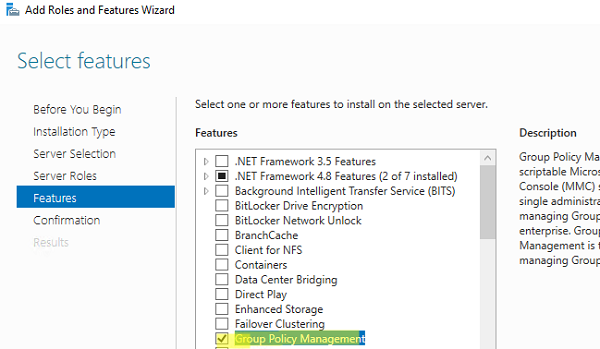
Также можно установить консоль GPMC в Windows Server с помощью PowerShell командлета Install-WindowsFeature:
Install-WindowsFeature GPMC

После установки, проверьте что ярлык Group Policy Management появится в разделе Administrative Tools в панели управления (Control Panel\System and Security\Administrative Tools). Ярлык ссылается на MMC оснастку
%SystemRoot%\system32\gpmc.msc
.
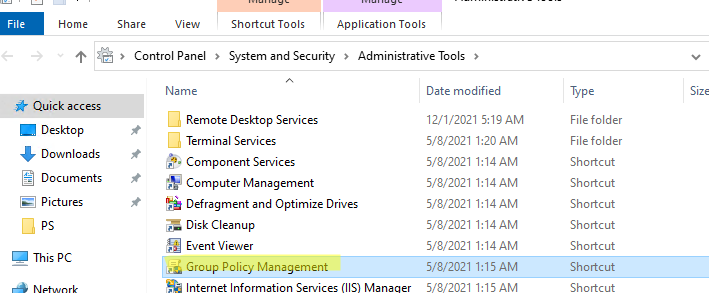
Управление групповыми политиками Active Directory с помощью консоли Group Policy Management
Консоль GPMC позволяет управлять групповыми политиками на уровне сайтов AD, доменов и организационными подразделениями (Organizational Unit).
Для запуска консоли выполните команду:
gpmc.msc
По умолчанию консоль подключается к контроллеру домена с FSMO ролью Primary Domain Controller Emulator (PDC). Вы можете подключиться к любому другому DC. Для этого щелкните правой кнопкой по имени домена и выберите Change Domain Controller (для комфортной работы рекомендуем подключиться к вашему Logon Server-у).
Разверните Forest -> Domain -> Ваш домен.
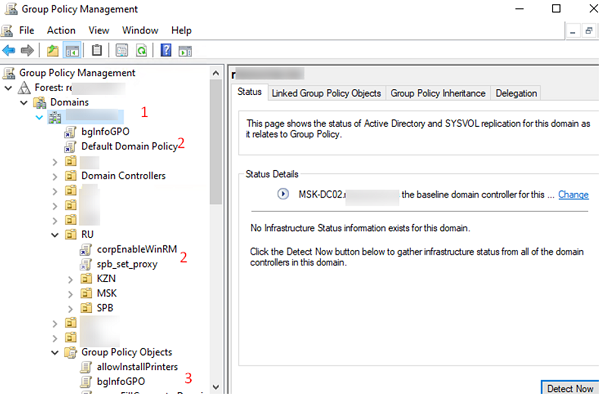
На этом скриншоте выделены:
- Имя домена, к которому подключена консоль;
- Групповые политики, которые назначены на различные OU (отображается вся структура OU, которую вы видите в консоли ADUC);
- Полный список политик (GPO) в текущем домене доступен в разделе Group Policy Objects.
Групповые политики Active Directory можно назначить на OU, сайт или весь домен. Чаще всего политики привязываются к OU с компьютерами или пользователями.
Чтобы создать новую GPO и сразу назначить ее на OU, щелкните по нужному контейнеру правой кнопкой и выберите Create a GPO in this domain, and Link it here.
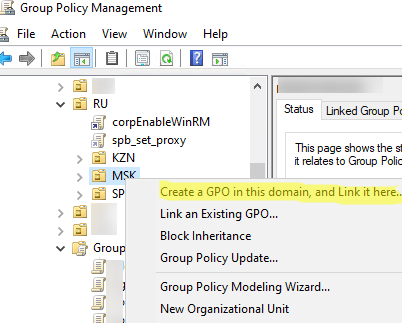
Задайте имя GPO:
В консоли GPMC вы увидите вашу новую GPO, которая сразу назначена на выбранный вами контейнер (OU).
GPO активна (
Link Enabled = True
), это значит что ее настройки будут применяться ко всем объектом в данном OU.
Чтобы изменить настройки GPO выберите Edit.
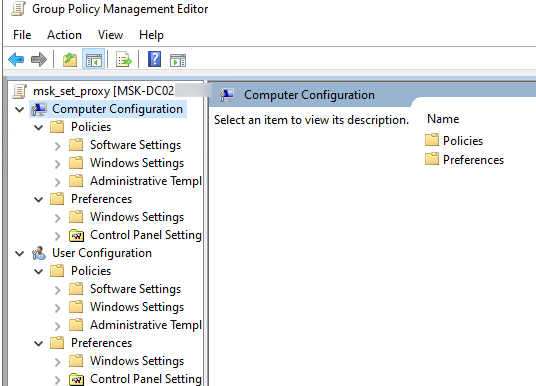
Для управления параметрами групповой политики на компьютере Windows используется консоль локального редактора GPO – gpedit.msc. Он позволяет настроить параметры Windows с помощью одной или множественных локальных политик (MLGPO).
Перед вами откроется консоль редактора GPO, аналогичная локальному редактору GPO. Все настройки GPO разделены на две секции:
- Computer Configuration — здесь можно настроить параметров компьютера (Windows);
- User Сonfiguration – параметры, которые нужно применить для пользователей AD.
В каждой секции есть три подраздела:
- Software Settings – используется для установки и обновления программ через GPO;
- Windows Settings — здесь расположены основные параметры безопасности Windows: настройки политики паролей, блокировки аккаунтов, политики аудита, назначения прав пользователей и т.д;
- Administrative Templates – содержит параметры различных компонентов Windows. Здесь доступны как стандартные административные шаблоны Windows, так и дополнительно admx шаблоны, установленные администратором (например, admx шаблоны для управления программами Microsoft Office или шаблоны для Google Chrome). Рекомендуем использовать центральное хранилище административных шаблонов GPO для удобства управления.
Также здесь есть отдельный раздел Preferences. Здесь содержится дополнительный набор настроек Group Policy Preferences (GPP), которые вы можете задать для клиентских устройств через GPO.
Закройте редактор политики и вернитесь в консоль GPMC. Все настройки, которые вы изменили в GPO будут применены на клиентах при следующем цикле обновления настроек групповых политик.
Выберите вашу GPO, чтобы вывести ее основные параметры. Здесь доступны 4 вкладки:
- Scope – здесь видно на какие OU назначена эта политики. В разделе Security Filtering можно настроить группы безопасности, для членов которых должна применяться политики (по умолчанию здесь задано Authenticated Users, это значит, что политика применяется ко всем объектам в OU). В параметре WMI filtering можно задать дополнительные правила фильтрации объектов для которых должна применяться GPO (см. WMI фильтры GPO);
- Details – содержится базовая информация о GPO (владелец, когда создана и изменена, версия, GUID);
- Settings – содержится отчет о всех настроенных параметрах GPO (отчет похож на результаты команды gpresult);
- Delegation – выводит текущие разрешения GPO, позволяет изменить их.
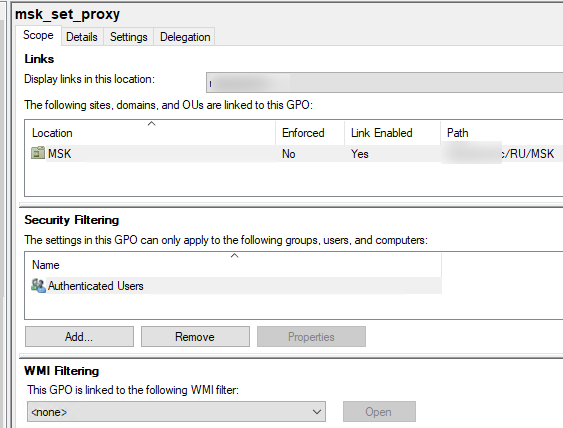
Active Directory хранит GPO хранятся в виде набора файлов и папок в каталоге SYSVOL, который реплицируется между DC. Вы можете найти каталог определенной GPO по ее GUID (на вкладке Details). Используйте следующий UNC путь:
\\winitpro.ru\sysvol\winitpro.ru\Policies\{GUID}

Если вы хотите, чтобы политика перестала действовать на клиенты в данном OU, можно либо удалить ссылку (
Delete
, при этом сама объект GPO не будет удален), либо временно отключить ее действие (
Link Enabled = False
).
Обратите внимание, что в домене уже есть две политики, которые действуют на все компьютеры и контроллеры домена соответственно:
- Default Domain Policy
- Default Domain Controller Policy
В большинстве случае не рекомендуется использовать эти GPO для настройки параметров клиентов. Лучше создать новые политики и назначить их на уровень всего домена или контейнера Domain Controllers.
Также консоль Group Policy Management позволяет:
- Импортировать/экспортировать, создавать резервные копии и восстанавливать GPO
- Создавать результирующие отчеты политик — Resultant Set of Policy (RSoP)
- Удаленно обновлять настройки GPO на компьютерах
- Подготавливать GPO к миграции между доменами
В отдельной статье “Почему не применяется групповая политика к компьютеру?” рассмотрены такие основные элементы групповых политик Active Directory как:
- Наследование в групповых полотках
- Область действия и порядок применения GPO (LSDOU)
- Приоритете и управление порядком применения политик
- Замыкание групповых политик (Loopback Processing mode)
- Фильтрация GPO
- Форсирование применения GPO
Рекомендуем внимательно ознакомиться с этой статьей для более эффективного использования возможностей групповых политик и понимания принципов их работы.
Last Updated :
07 Apr, 2025
Opening the Local Group Policy Editor in Windows Home can be tricky, as this feature is typically unavailable in the Home edition by default. However, workarounds exist to access Group Policy on Windows Home and manage system policies effectively. In this guide, we’ll show you how to enable Group Policy Editor in Windows Home and navigate the Group Policy settings to customize your system preferences.
Table of Content
- How to Access the Group Policy Editor in Windows Home?
- Method 1: Using Search Bar
- Method 2: Using Run Dialog
- How to Configure Windows Settings Without the Group Policy Editor?
- How to Enable Group Policy Editor (gpedit. msc) on Windows 10/11 Home Edition?
- Method 1: Using PowerShell Script
- Method 2: Using GPEdit Installer
What Is Group Policy Editor in Windows?
The Group Policy Editor, an administrative tool in Windows, enables the configuration of various operating system aspects. It offers a user interface that manages policies influencing the system’s behavior and user experience. It allows you to control how the system works and what users can do, like setting passwords, blocking certain programs, or changing desktop settings.
How to Access the Group Policy Editor in Windows Home?
Users can access the Local Group Policy Editor directly on Windows Professional or Enterprise editions. However, Home edition users must implement a workaround to access this feature, as it is not included by default.
Method 1: Using Search Bar
Step 1: Press WindowsKey + S then on the search bar type «Edit group policy«
Step 2: On the right side click on «open«
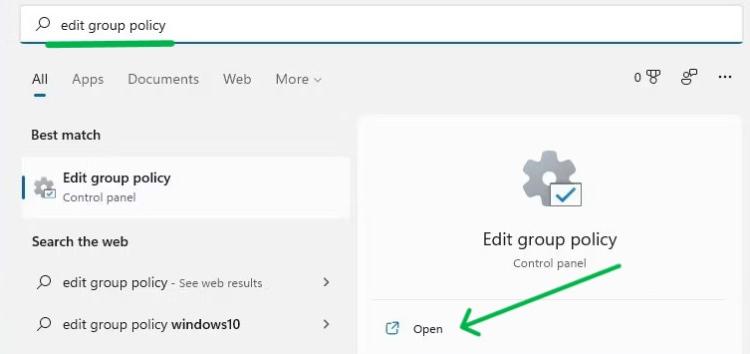
Method 2: Using Run Dialog
Step 1: Press Windows + R then on run dialog type «gpedit.msc«
Step 2: Press the Enter button or OK to open the group policy on Windows home
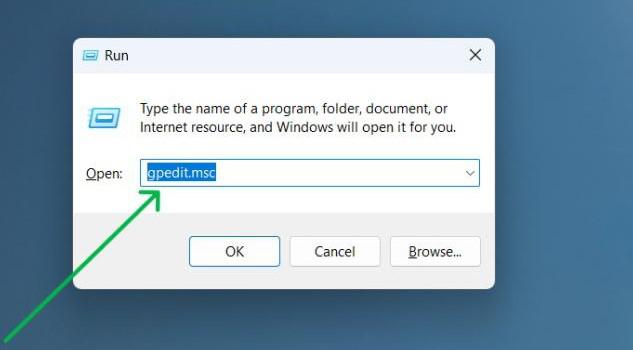
How to Configure Windows Settings Without the Group Policy Editor?
To Open the Group Policy editor, Users of Windows Home editions must use alternative methods to configure system settings typically managed by the Group Policy Editor. These methods can include direct registry edits or the use of third-party software solutions.
Policy Plus, a free and open-source tool, extends the capabilities of Group Policy settings to all Windows editions, beyond just Professional and Enterprise. It empowers users to view and edit Registry-based policies across local GPOs, per-user GPOs, individual POL files, offline Registry user hives, and the live Registry.
You can download Policy Plus from GitHub:
https://github.com/Fleex255/PolicyPlus
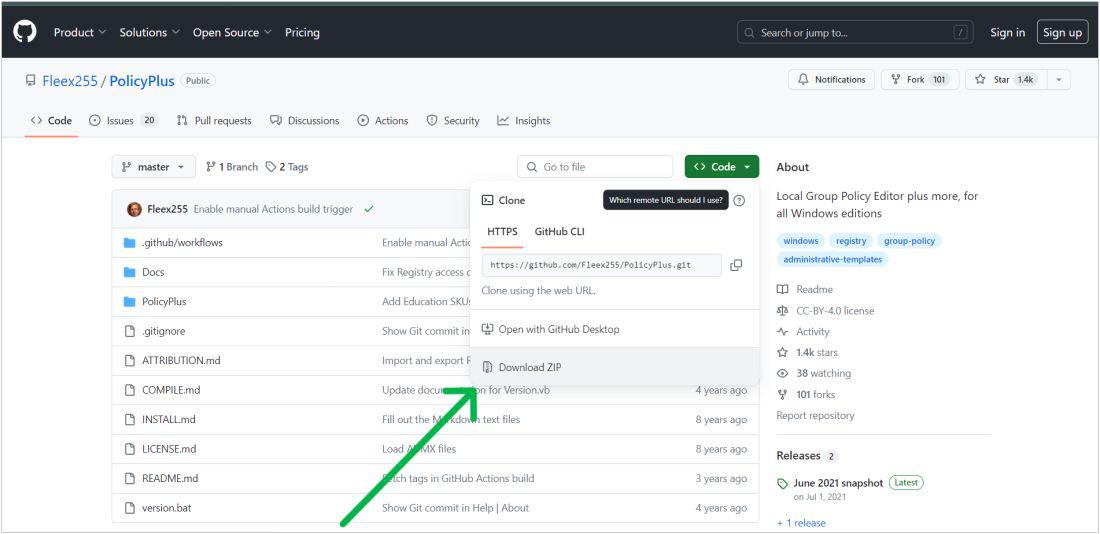
How to Enable Group Policy Editor (gpedit. msc) on Windows 10/11 Home Edition?
To enable the Group Policy Editor on Windows Home editions, you can use any method like GPEdit Installer or PowerShell Script to enable the Group Policy Editor on Windows Home edition.
Method 1: Using PowerShell Script
For the more technically inclined, enabling the Group Policy Editor via a PowerShell script is an efficient way to activate this feature. This method involves executing a script that automates the installation process, providing a swift and direct approach to accessing the Group Policy Editor on Windows Home Editions.
Step 1: Open Notepad
Step 2: Copy this code and paste it into Notepad and save as it a .batfile
@echo off
pushd "%~dp0"
dir /b %SystemRoot%\servicing\Packages\Microsoft-Windows-GroupPolicy-ClientExtensions-Package~3*.mum >List.txt
dir /b %SystemRoot%\servicing\Packages\Microsoft-Windows-GroupPolicy-ClientTools-Package~3*.mum >>List.txt
for /f %%i in ('findstr /i . List.txt 2^>nul') do dism /online /norestart /add-package:"%SystemRoot%\servicing\Packages\%%i"
pause
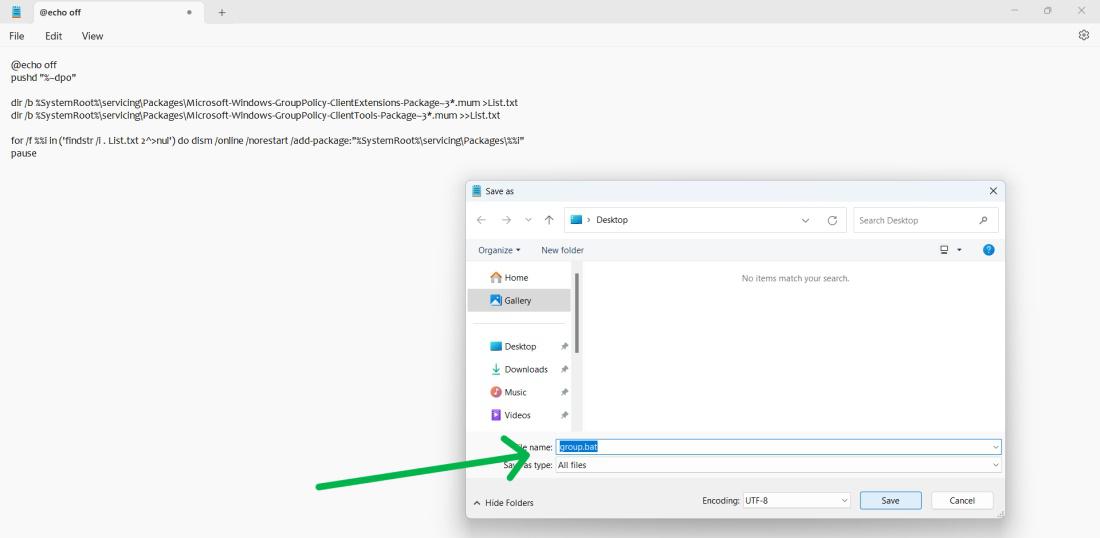
Step 3: After that click on the saved file and select «Run as administrator» from the menu
Step 4: After completion, press any key to close the Command Prompt
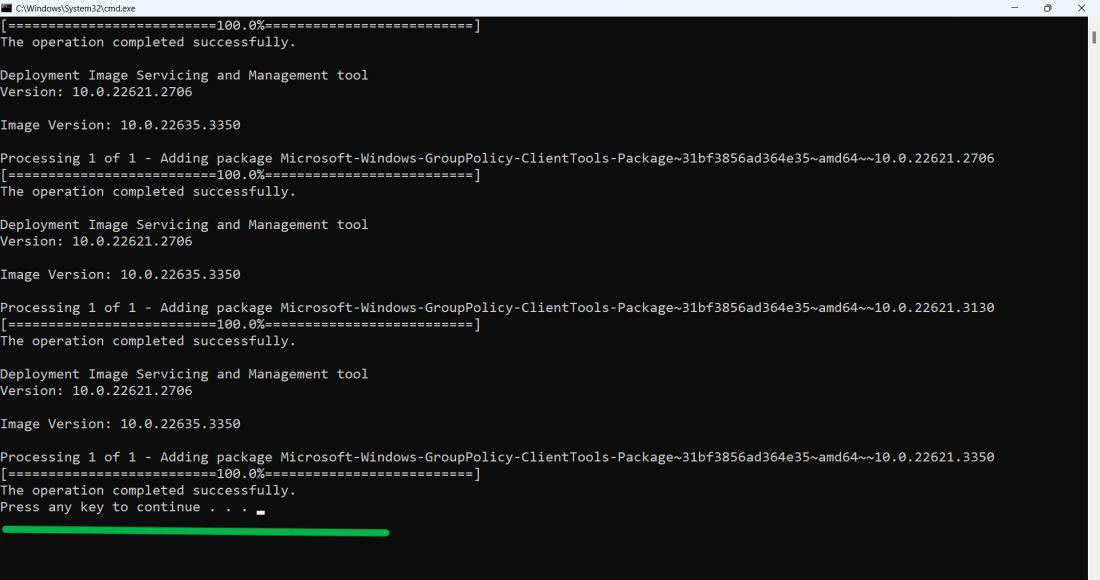
Step 5: Restart Your computer
Method 2: Using GPEdit Installer
Unlocking the Group Policy Editor in Windows Home Edition is made simple with the GPEdit Installer. This method provides a hassle-free installation process, allowing users to quickly gain access to the editor’s extensive settings and configurations without complex procedures.
Step 1: Download the setup file from this link
https://bit.ly/3INu7Xg
Step 2: Double-click on the setup.exe file then click on «next«
Step 3: Select Install
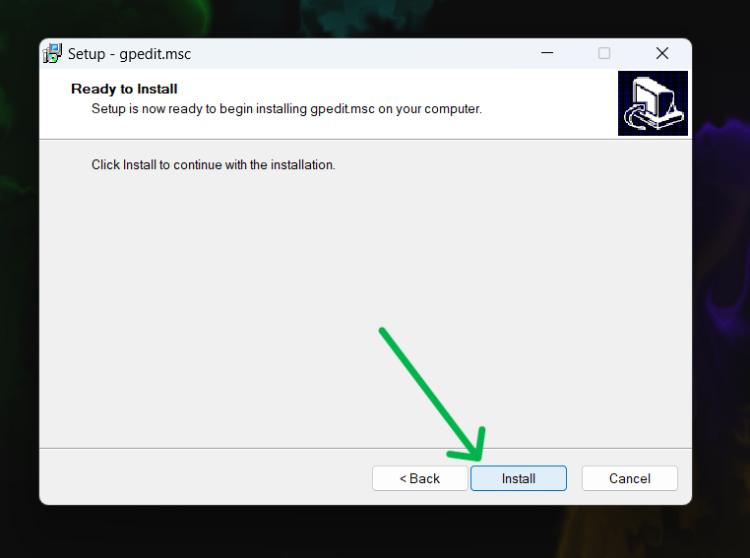
Step 4: After clicking on the install button a window will be pop
Step 5: Restart your computer
Also Read
- How to Fix the “Cannot Find Gpedit.msc” Error on Windows 11?
- How to Stop Windows 10 Update Permanently?
- How To Change Network Settings of Window From Public to Private?
Conclusion
Though Windows Home doesn’t natively include the Local Group Policy Editor, you can use a workaround to install and open Local Group Policy Editor in Windows Home. By following these steps, you’ll be able to adjust important Group Policy settings that are normally reserved for Pro and Enterprise editions. Understanding how to use Group Policy Editor in Windows Home can help you manage your system more effectively and unlock additional control over your PC.
Многие инструкции по настройке и решению проблем с Windows 10, 8.1 или Windows 7 содержат, среди прочих пунктов «Откройте редактор групповой политики», однако не все начинающие пользователи знают, как это сделать. В этой инструкции подробно о том, как открыть редактор локальной групповой политики несколькими способами.
Заранее обращу внимание на то, что эта системная утилита присутствует только в Корпоративной и Профессиональной версиях Windows 10, 8.1 и Windows 7 (для последней — также в редакции «Максимальная». В Домашней вы получите сообщение о том, что запустить инструмент не удается, хотя это можно и обойти, подробно: Не удается найти gpedit.msc в Windows.
Способы открыть редактор групповой политики (gpedit.msc)
Ниже — все основные способы запуска редактора локальной групповой политики. Существуют и другие, но они являются производными от описанных далее.
Диалоговое окно «Выполнить»
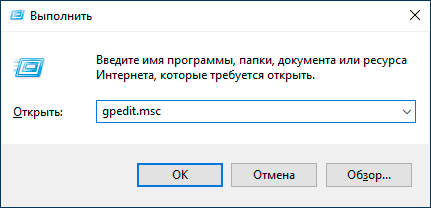
Первый способ, о котором я пишу чаще других, подходящий для всех актуальных версий Windows — нажать клавиши Win+R (Win — клавиша с эмблемой ОС), и в открывшееся окно «Выполнить» ввести gpedit.msc
После этого нажмите Enter или Ok — сразу откроется интерфейс редактора локальной групповой политики, при условии его наличия в вашей редакции системы.
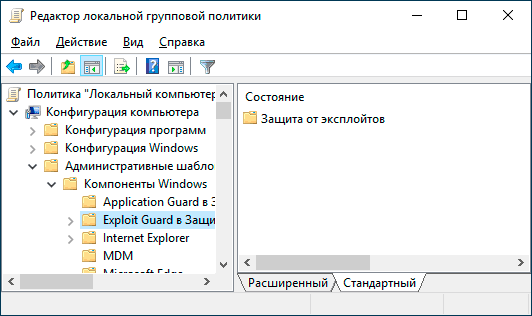
Файл gpedit.msc
Вы можете запустить редактор локальной групповой политики, а также создать ярлык для него в нужном вам расположении, используя файл для запуска: он находится в папке C:\Windows\System32 и имеет имя gpedit.msc
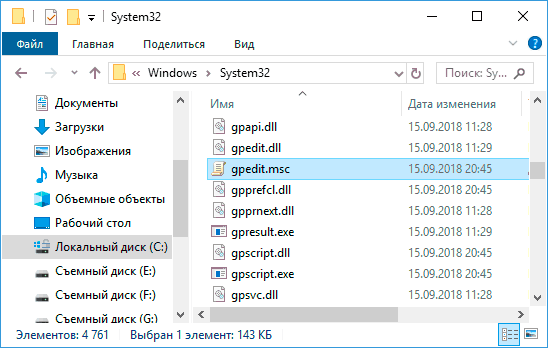
Поиск Windows 10, 8.1 и Windows 7
Одна из функций ОС Windows, которой пользователи незаслуженно не уделяют внимания — поиск в системе, который в Windows 7 находится в меню «Пуск», в Windows 10 — в панели задач, а в 8.1 — в отдельной панели поиска (можно вызвать клавишами Win+I). Если вы не знаете, как что-либо запустить, используйте поиск: обычно, это самый быстрый способ.
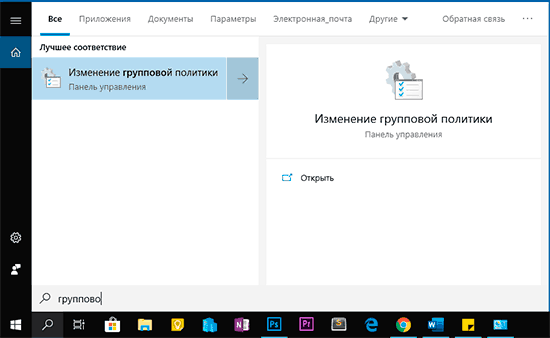
Однако, по какой-то причине, нужный результат находится только если вводить «Групповой политики», без слова «Редактор». По этому же запросу нужный результат можно найти в поиске в «Параметры» Windows 10.
Панель управления
Запуск редактор локальной групповой политики возможен из панели управления, однако тоже с некоторыми странностями: он должен находиться в разделе «Администрирование», однако если его открыть, такого пункта там не будет (во всяком случае в Windows 10).
Если же начать вводить «Групповой политики» в поиске в панели управления (в окно справа вверху), редактор будет найден именно в разделе «Администрирование».
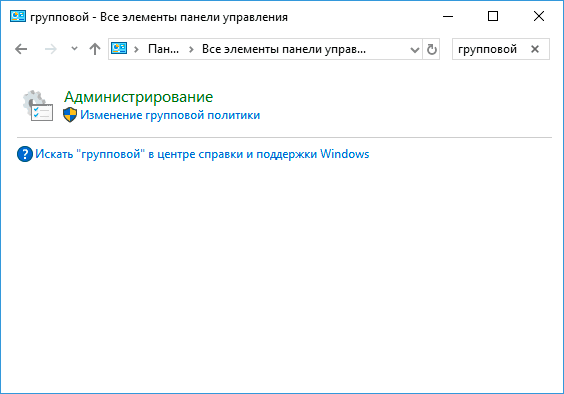
Все остальные способы — по сути варианты уже описанных: например, gpedit.msc вы можете запустить из командной строки или PowerShell, ярлык к файлу gpedit.msc можно закрепить на панели задач или в меню Пуск. Так или иначе, думаю, что описываемых методов для ваших целей окажется достаточно. Также может быть полезным: Редактор локальной групповой Windows политики для начинающих.
The Group Policy Editor in Windows 11 and Windows 10 is a Microsoft Management Console that allows users access to the Computer and User Management Settings that could be changed. One can access settings such as changing the processes a user on the computer could open, manage the apps, and a lot more. Not to be visible to an average user, this option is hidden. So if you are interested in opening it, Here’s how you can open a Group Policy Editor on Windows 11/10.
Note: Group Policy Editor is not available for Windows 11/10 Home version. To enable it, follow this guide.

This tool is not meant for beginners, and thus so the location of the tool is hidden and is not directly available through the Start Menu. Here’s the list of methods we will be following in the below guide to open Group Policy Editor on Windows 10
- Search Box
- Settings Panel
- Control Panel
- Run Dialog
- Command Prompt
- Create a Shortcut for Group Policy Editor on Windows.
Group Policy can enable or disable many things in Windows, so make sure you understand what you plan to change on the computer. Also, Group Policy Editor creates an entry in the registry and is a safer way instead of directly changing via a registry entry.
1] Search Box

The Search Box is used for searching files across the drive and could perform our required function as well. To open the Windows Group Policy Editor via the Search Box, Fire up the search box by either clicking the ‘Windows’ Logo or clicking on it.
Next, Search for Edit Group Policy or gpedit.msc would bring up the Group Policy Editor as the main result. Tap on the required application, and you are good to go.
2] Run Dialog

We all do use the Run Dialog to launch applications or a specified location quickly. We could also use the Run Dialog in this case. Here’s how:
Quickly launch the Run Dialog by pressing the Win + R button simultaneously or head over to the search box and open it via there. Next, in the Run Dialog, type in gpedit.msc and press Enter to run it.
3] Command Prompt

While you can use the Command Prompt for executing queries and commands, here’s how you can use it to complete our required function of opening the Windows Group Policy Editor.
Fire up the Command Prompt or a Powershell window using the Search Box, the Run Dialog, or any other method. Next, In the command line, type in gpedit.msc and press Enter to run the command.
4] Windows Settings

As discussed earlier, you can also use the Group Policy Editor on Windows 11/10 to change/modify the settings, and hence as the name suggests, it could be accessed from the Settings Panel. To do so, Open the Settings Panel either via the Search Box or directly from the Start Menu. In the Search Box, type in Group Policy Editor and select the main listed result.
5] Control Panel

Another way to access the Group Policy Editor on Windows 11/10 is via the classic Control Panel. So, open the Control Panel first. At the top right corner, click on the search box, and search for Group Policy Editor. In the results, under the Administrative Tools menu, you’ll find the result for the Edit Group Policy, click on it, and you’re good to go.
A point here to be noted is, although the Windows Group Policy Editor is available under the Administrative Menu in the search results, if you open the Control Panel and head over to the Administrative Menu directly, you won’t be in a position to find it. So, the only method to access it via the Contol Panel is using the Search Box.
6] Create a Shortcut to the Group Policy Editor on the Desktop

If you are a person, who keeps accessing the Group Policy Editor often, we would recommend you create a shortcut on the Desktop using the method attached to save some time. On the Desktop, in a blank space, make a Right-Click. In the menu that pops up, Under the New options, select Create New Shortcut.
This will open a new menu to create a shortcut. In the menu, type in gpedit.msc and click Next. This will create a shortcut on the Desktop.
I hope the post was useful, and you were able to learn multiple ways to open Group Policy Editor in Windows 11/10.
How do I edit Group Policy in Windows?
Once the Policy editor is open, locate the policy. Then you can choose between Not configured, enabled, or disabled. Click on Finish to commit the changes.
Does Windows Home have Group Policy Editor?
It is not enabled by default for the Home version. However, it is still possible to enable it using a built-in tool. It will download the Group Policy Editor, and you can then find and launch it.
Why Does Gpedit MSC Not Work?
Make sure to launch it with admin permission if the tool doesn’t show the UAC prompt when you open it.
How Do I Fix Setup Blocked by Group Policy?
- Open the Group Policy Editor.
- Navigate to User Configuration > Administrative Templates > System.
- Locate the Don’t run specified Windows applications policy.
- Click on the Show button.
- Remove the blocked program or application from the disallowed list.
- Relaunch the program.
Related: How to launch a program with advanced run options with a right-click with admin permission.
A long-standing Windows fan, Photographer, and Tech Enthusiast who loves to write about Smartphones and Technology.
If you are a computer geek, you may already know the built-in Group Policy Editor (gpedit.msc) in Windows 11 and 10. It is used only to manage the policies of the local computer. But if you are a domain administrator within an organization, you may also need the Group Policy Management Console, a.k.a. GPMC.
The two tools are slightly different from one another but perform the same tasks. Today we are going to talk about what the Group Policy Management Console is and how to install it on your Windows computer.
Table of Contents
What is Group Policy Management Console (GPMC)
The Group Policy Management Console is part of the Remote Server Administration Tool (RSAT) that unifies Group Policy management across the entire domain. So, if an administrator wants to manage the domain’s Group Policy from a Windows operating system (as opposed to a Windows Server), they will need to install the GPMC.
Before GPMC, administrators had to open different tools to get the job done, such as the following:
- Active Directory Users and Computers
- Active Directory Sites and Services
- Resultant Set of Policy
- ACL Editor
- GPMC Delegation Wizard
However, with GPMC, all these attributes are centralized under a single tool. Moreover, it also has the following attributes:
- A convenient User Interface (UI).
- Backup, restore, import, and copy Group Policy objects (GPOs).
- Simplified management of Group Policy-related security.
- Reporting of GPO settings and Resultant Set of Policy (RSoP) data.
- Programmatic access to the preceding GPO operations.
That said, GPMC needs to be installed on a Windows computer to use it.
Install Group Policy Management Console (GPMC) on Domain Computer
Note: To use GPMC after installation, you must be signed in as a domain user and not as a local computer user. Otherwise, you will see the following prompt:
Perform the following steps to install GPMC on a Windows computer connected to your enterprise’s domain:
-
Navigate to the following:
Settings app >> Apps >> Optional Features
-
Here, click View features in front of “Add an optional feature.”
View optional features -
In the “Add an optional feature” popup, search for “Group policy.” Then, check the box next to “RSAT: Group Policy Management Tools” and click Next.
Select feature -
On the next page, click Install.
Install feature
The Group Policy Management Console will now be installed on your PC.
How to Open Group Policy Management Console (GPMC)
Once GPMC is installed, there are 2 methods to open it.
Using GPMC.MSC Cmdlet
One way is by calling the Microsoft Management Console (MMC) through the command line. To do so, simply type in the following in either the Run Command box, Command Prompt, or Windows PowerShell and hit Enter.
gpmc.mscAnother way to go about it is through the Microsoft Management Console Snap-in.
From MMC Snap-In
Perform the following steps to open and connect GPMC to your domain controller:
Note: To connect GPMC to your domain controller successfully, make sure that your network configuration is correct, meaning the Windows device can communicate with the Domain Controller.
-
Open the Microsoft Management Console by typing in MMC in the Run Command box.
Open MMC -
Click File and then click “Add/Remove Snap-in.”
Add/Remove Snap-in -
From the popup window, select “Group Policy Management Editor” under Available snap-ins and click Add.
Add snap-in -
You will now be asked to add a Group Policy Object (GPO). Click Browse and select the domain. When selected, click Finish.
Add Group Policy Object -
Now back in the “Add or Remove Snap-ins” window, click Ok.
Click Ok
You can now begin managing your domain’s Group Policy from a Windows computer with this simple RSAT GPMC tool.
Closing Words
The GPMC is a centralized administrative tool you can use on a client PC, without having to transfer to a Windows Server computer. However, if you are using the Home edition of Windows OS, you cannot install RSAT tools on it, which in turn prevents you from installing the Group Policy Management Tools.
Frequently Asked Questions
Can an administrator launch the Group Policy Management Console (GPMC) from a workstation?
Yes, a domain administrator can launch and use the Group Policy Management Console from a workstation. However, they need to be using either the Pro or Enterprise edition of Windows and have the Remote Server Administration Tools (RSAT) installed, with the Group Policy Management Tools present in specific.
Can Remote Server Administration Tools (RSAT) be installed on Windows Home edition?
The RSAT packages are only available to download in Windows Professional and Enterprise editions. Thus, cannot be installed on the Home edition.
How to open the Group Policy Management Console (GPMC)?
The quickest method to open the Group Policy Management Console is by typing in gpmc.msc in the Run Command box.







